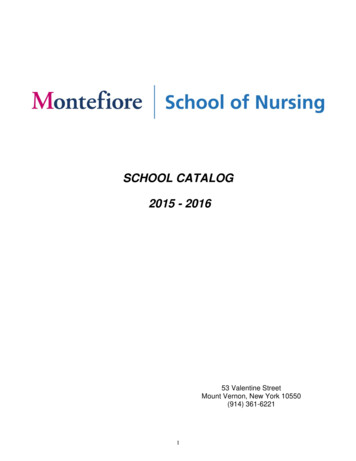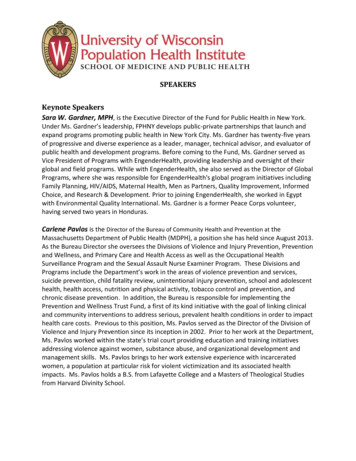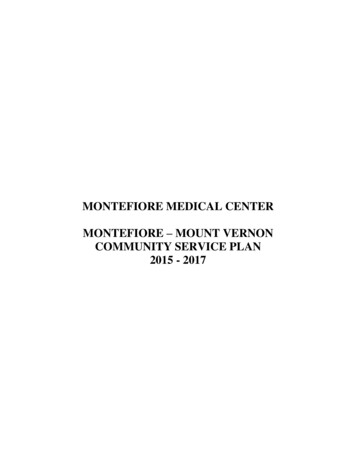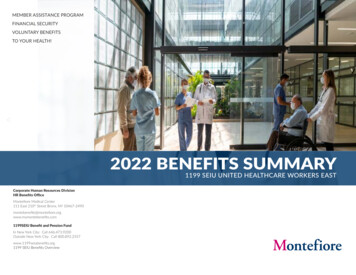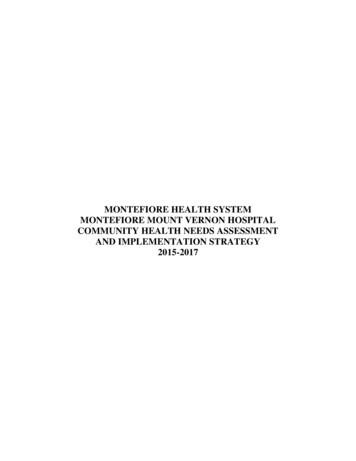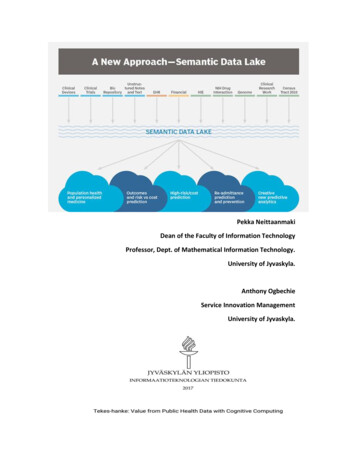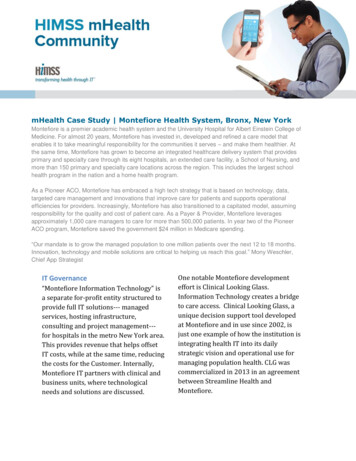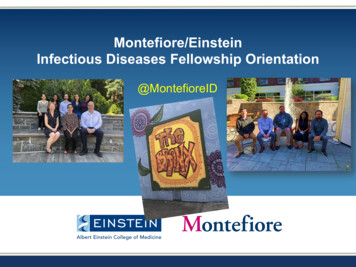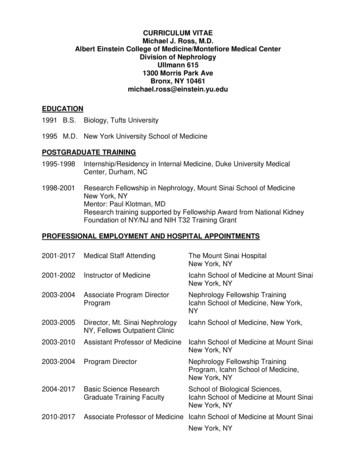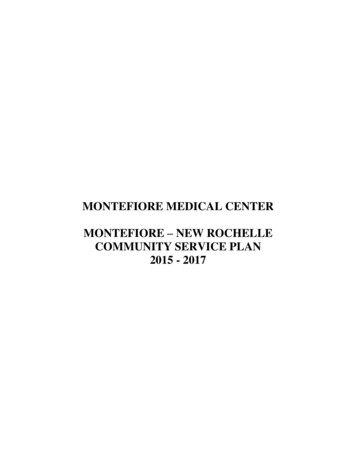
Transcription
MONTEFIORE MEDICAL CENTERMONTEFIORE – NEW ROCHELLECOMMUNITY SERVICE PLAN2015 - 2017
Montefiore Medical CenterMontefiore – New RochelleCommunity Service Plan 2015-2017Table of ContentsPage1. Mission Statement12. Definition and Description of the Community ServedA) Description of Service AreaB) Population of Mount VernonC) Health Status of the City of Mount Vernon33553. Public Participation324. Assessment and Selection of Public Health Priorities335. Two Year Plan of Action - 2014-2017Prevent Chronic DiseasePromote Healthy Women, Infants and Children3738406. Dissemination of the Report to the Public427. Maintaining Engagement438. Financial Aid44Appendix A: Data Sources DefinitionAppendix B: ReferencesAppendix C: Health Needs with Significance and Magnitude454956
1. Mission Statement: A Longstanding Commitment, A New FocusMontefiore Health System is a premier academic health system and the University Hospital forAlbert Einstein College of Medicine. Combining a nationally-recognized clinical excellence witha population health perspective that focuses on the health needs of communities, Montefioredelivers coordinated, compassionate, science-driven care where, when and how patients need itmost. Montefiore consists of six hospitals and an extended care facility with a total of 2,080 beds,a School of Nursing, and state-of-the-art primary and specialty care provided through a networkof more than 150 locations across the region, including the largest school health program in thenation and a home health program.Montefiore's partnership with Einstein advances clinical and translational research to acceleratethe pace at which new discoveries become the treatments and therapies that benefit patients. Themedical center derives its inspiration for excellence from its patients and community, andcontinues to be on the frontlines of developing innovative approaches to care.Montefiore’s Mission Statement and Strategy:In January 2009, Montefiore Medical Center completed a comprehensive review and update ofits strategic plan. The process included the development and approval by its Board of Trusteesof revised statements of the medical center’s Mission, Vision and Values.Mission:To Heal, To Teach. To Discover and to Advance the Health of the Communities We Serve.Vision:To be a premier academic medical center that transforms health and enriches lives.Values:Humanity, Innovation, Teamwork, Diversity and EquityAs part of that process, Montefiore established five Strategic Goals; setting out Montefiore’scourse for the decade to come:1. Advance our partnership with the Einstein College of Medicine2. Create notable Centers of Excellence3. Build specialty care broadly4. Develop a seamless delivery system with superior access, quality, safety and patientsatisfaction5. Maximize the impact of our community service1
The inclusion of an explicit statement affirming Community Service as part of Montefiore’sMission Statement is not new. It has always been one of the core elements of Montefiore’smission. What has changed is the explicit reference to “advancing the health of thecommunities we serve”, focusing on making a measurable difference in the health of thosepopulations and communities. This is further sharpened by the inclusion as one of the fivestrategic goals the imperative, to “maximize the impact of our community service.”In pursuing that goal, Montefiore has tasked itself:To better coordinate and focus its resources on specific high prevalence/high impactproblems affecting its community;To work internally and with community partners to identify priority health needs, and;To develop and implement more effective broad-based plans of action to address them,and to advance the health of the communities we serve.The rationale behind this change was the realization that we must focus our efforts, if we are tomake a real, measurable difference in the health of populations, and communities. That isessentially the same logic as underpins the state’s revised Community Service Plan process.Historically, Montefiore has earned a reputation as a leader in the region, state and nation inproviding services to its community, by developing and operating an extraordinary array ofneeded services to the poor and underserved, and to specific at-risk populations (eg. children, theelderly, the HIV-infected, the homeless and victims of domestic violence).Montefiore New Rochelle Hospital is a 242-bed, community-based teaching hospital offeringprimary, acute and emergency care to the residents of southern Westchester. Since its foundingin 1892, Montefiore New Rochelle Hospital has provided for the diverse medical needs of thecommunity and region it serves. The Hospital is part of Montefiore Health System, a premieracademic medical center and the University Hospital System for Albert Einstein College ofMedicine.As of November 6, 2013, as a part of the Montefiore Health System, a premier academic medicalcenter and the University Hospital system for Albert Einstein College of Medicine, MontefioreNew Rochelle Hospital continues to provide inpatient, critical care and ambulatory services.Montefiore New Rochelle has a number of leading-edge services and programs that have earneddistinction by state and national organizations for achieving and maintaining the highest qualityof care within the specialty, including:Designated as a Center of Excellence by the American Society of Metabolic and BariatricSurgeryNew York State-designated Stroke CenterNew York State-designated Area Trauma Center—the only one in southern WestchesterNew York State-designated perinatal hospital with a Level 3 Neonatal Intensive Care Unitthat provides state-of-the-art care for fragile newbornsGold Seal of Approval from The Joint Commission as a certified Center of Excellence inboth hip and knee joint replacement2
2. Definition and Description of the Community Serviced: Hospital Service AreaA. Description of Service AreaMontefiore New Rochelle Hospital has identified the city of New Rochelle and its surroundingtowns and villages as its primary service area. Montefiore New Rochelle Hospital is the onlyhospital in the City of New Rochelle, which is a south eastern city in Westchester Countybordered to its east by the Long Island Sound, on the west by Pelham, PelhamManor and Eastchester, by Scarsdale to the north and east, Mamaroneck and Larchmont to theeast. The city lies 2 miles (3.2 km) north of the New York City border (Pelham Bay Park in TheBronx). It is the seventh largest city in New York State. According to the United States CensusBureau, the city has a total area of 13.2 square miles (34.3 km2). The city has a rough triangleshape, approximately 10 miles (16 km) from north to south and 1.5 miles (2 km) from east towest at its widest pointThe communities served by the MNRH are extremely diverse. The service area contains pocketsof prosperity, where health insurance coverage is more prominent, along with manyeconomically challenged neighborhoods whose residents are uninsured or underinsured. Most ofthe latter do not access healthcare routinely but rather present only in crisis through theEmergency Department.New Rochelle is a diverse urban setting, with multiple sub-populations that evidence tremendousvariation. In addition to Montefiore New Rochelle, the community is served by manyindependent providers including neighboring hospitals/systems, and a Federally Qualified HealthCenter, which has an overlapping service area. In this setting, the focus is on specific healthneeds of specific populations, in targeted communities, working with specific partners to addressthe needs of this community. The ability to apply services in a targeted fashion has beenMontefiore’s historical approach to developing and operating its programs of community health,and that is the approach we have taken in developing this Community Service Plan.3
New Rochelle Service Area4
B. Population of New RochelleAccording to the 2013 American Community Survey of the U.S. Census, New Rochelle hasapproximately 78,400 residents. There are approximately 28,000 households in New Rochelle.The average household size is 2.71 people. Families made up 68% of the households; includesboth married-couple families (48.9%) and single householder families (28.1% total—5.9% male,13.2% female). Nonfamily households consist of 32% of all households in New Rochelle;includes people living alone and non-related people living under one household. 32.8% ofhouseholds include one or more people under 18 years of age. 29.6% of households include oneor more people 60 years of age or older.New Rochelle is ethnically diverse. Its population is 28.5% Hispanic, 17.8% African-American,69.6% White, 4% Asian, and 7% other. Almost one-third (26.3%) of its residents are foreignborn. Among these immigrants, more people speak only English at home than any otherlanguage. The city’s immigrant communities come from diverse corners of the globe (in order oftheir numbers): Mexico, Colombia, Italy, Jamaica, Guatemala, Peru, Haiti, Brazil, China, andPortugal.New Rochelle is one of Westchester County’s more affluent cities. Reflecting 2013 data from theUS Census Bureau’s American Community Survey, 1% of New Rochelle households are onpublic assistance; less than the Westchester County (2.2%) and New York State (3.4%)percentages.10.4% of New Rochelle’s population lives below the poverty line and the medianincome is 66,656 (compared to 77,293 countywide). There are 12.2% of New Rochellechildren living below poverty. The unemployment rate in New Rochelle is 7.5%; less than thecountywide (8.4%) and statewide (9.2%) rates. 82.3% of New Rochelle residents ages 25 andolder have received their high school diploma or GED; lower than both the countywide rate of87.4 and lower than the statewide rate of 85.6%.C. Health Status of the City of New RochelleThe health status of the city of New Rochelle was measured across the indicators of overallhealth status as well as indicators of the social, environmental, and economic determinants ofhealth. The prevalence and/or incidence of both clinical and social determinants of health arereported from multiple sources, as detailed within the sections below. While there are areas ofimprovement, New Rochelle’s rates are comparable to the midline, when compared to theremainder of Westchester County. When local municipality data is unavailable, County leveldata is provided.The residents in New Rochelle have significantly high mortality rates from heart disease, cancer,stroke, and chronic lower respiratory diseases (CLRD).Mortality Rates:According to the New York State Department of Health’s (NYSDOH) Vital Statistics ofNew York State report in 2011, Westchester County (which includes the city of New Rochelle)has an age-adjusted mortality rate of 713.4 per 100,000; similar to the statewide rate of 753.1.According to the Community Health Rankings in 2014, Westchester County ranked as number 3out of 62 NY counties to have the lowest mortality rate in New York State. The leading cause ofdeath among Westchester County residents is due to coronary heart disease (219.7 per 100,000).5
Asthma & CLRD:According to the NYSDOH, 8.7% of Westchester County adults had asthma from 20082009; lower than the statewide percentage of 9.7%.According to CDC data, the percentage of Westchester County adults with asthmaincreased to 14% from 2011-2012; same percentage as New York State.According to an asthma report from New York State Office of the State Comptroller, theasthma prevalence rate among Westchester County Medicaid recipients was 86.7 per 1,000 from2008-2009. The prevalence rate increased to 98.4 per 1,000 from 2012-2013; similar to thestatewide prevalence rate of 98.7.The average (age-adjusted) rate of asthma emergency department visits per 10,000 from2011 was 64.2 in Westchester County. In 2012, the rate of asthma emergency department visitsincreased to 67.4 per 10,000.In 2010, the age-adjusted death rate due to chronic lower respiratory diseases amongWestchester County residents was 24.3 per 100,000; lower than the statewide rate of 31.1. In2011, Westchester County ‘s death rate decreased to 23.4; remaining lower than the statewiderate of 31.2.Heart Disease & Stroke:The coronary heart disease mortality rate per 100,000 in Westchester County was 119.5in 2011; similar to the 2010 rate of 117.1. The coronary heart disease hospitalization rate per10,000 in Westchester County was 35.8 in 2011; similar to the 2010 rate of 36.4.The cerebrovascular disease (stroke) mortality rate per 100,000 in Westchester Countywas 25.8 in 2011; an increase from the 2010 rate of 24.0. The stroke hospitalization rate per10,000 in Westchester County from 2009-2011 was 22.8; similar to the statewide rate of 24.9.The cardiovascular disease mortality rate per 100,000 in Westchester County was 199.2in 2011; an increase from the 2010 rate of 195.5. The cardiovascular disease hospitalization rateper 10,000 in Westchester County was 133.1; similar to the 2010 rate of 135.9.Cancer:The mortality rate of all cancer diagnoses in Westchester County was 150.5 in 2010;similar to the statewide rate of 160.2. The type of cancer with the highest mortality rate inWestchester County is lung cancer (36.9 per 100,000; lower than the statewide rate of 41.8).The incidence rate of all cancer diagnoses in Westchester County was 495.2 per 100,000in 2010; similar to the statewide rate of 482.5. The type of cancer with the highest incidence ratein Westchester County is prostate cancer (22.6 per 100,000; similar to the statewide rate of 21.3).6
Health Status of the City of New Rochelle: Health Indicators and Data SourcesHealth Indicators1. Access to Quality Health ServicesAccording to the U.S. Census Bureau, 84.4% of adults (see Figure 1a) and 99.7% ofchildren in New Rochelle had health insurance in 2012. The percentage of NewRochelle adults with health insurance in 2012 was higher than the Westchester Countypercentage and similar to the New York State (NYS) percentage (see Figure 1b). Thepercentage among children in New Rochelle in 2012 was higher than the countywideand statewide percentages (see Figure 1c).In 2013, the percentage of New Rochelle residents with health insurance decreased to82.3% for adults (see Figure 1a) and 96.5% for children. The percentage of NewRochelle adults with health insurance in 2013 was lower than the Westchester Countyand NYS percentages (see Figure 1b). The percentage among New Rochelle childrenin 2013 was lower than the countywide percentage and similar to the statewidepercentage (see Figure 1c).Percentage with Health InsuranceFrom 2012-2013, New Rochelle children were more likely to have health insurancecoverage than New Rochelle adults. In 2012, the percentage of New Rochelle childrenwith health insurance was higher than the overall percentages among children inWestchester County and New York State. The percentage of New Rochelle adults andchildren with health insurance decreased over the years. Despite the decrease in 2013,the percentage of New Rochelle children remained higher than that of New Rochelleadults.Figure 1a. Residents with Health Insurance: New Rochelle %Adults30%Children20%10%0%20122013Year of DataSource: U.S. Census Bureau (American Community Survey, 2012 & 2013)7
Figure 1b. Percentage of Adults with Health Insurance:New Rochelle, Westchester County, & New York State 2012-201384.4%2012New RochelleYear of Data83.3%84.6%WestchesterCountyNew York ge with Health InsuranceSource: U.S. Census Bureau (American Community Survey, 2012 & 2013)Figure 1c. Percentage of Children with Health Insurance:New Rochelle, Westchester County, & New York State 2012-2013Year of Data99.7%201297.0%96.1%96.5%201397.0%New RochelleWestchesterCountyNew York State96.0%0%20%40%60%80%100%Percentage with Health InsuranceSource: U.S. Census Bureau (American Community Survey, 2012 & 2013)Preventable Hospital Stays: Top 20 Inpatient DiagnosesFigure 1d illustrates 20 ailments with the highest total number of patient diagnoses throughoutNew Rochelle (zipcodes: 10801; 10802; 10804; & 10805) from 2011-2013. The total number ofpatients diagnosed with each of the top 20 ailments represents hospital discharges among allNew Rochelle residents. These ailments were categorized using the DRG coding system.8
From 2011-2013, Psychoses had the highest total number of inpatient diagnoses in NewRochelle.Among the top 20 inpatient diagnoses, Seizures without Major Complications &Comorbid Conditions had the lowest total number of inpatient diagnoses in NewRochelle from 2011-2013.The following diagnoses have decreased over the 2011-2013 period in the following areacodes:o Psychoseso Septicemia or Severe Sepsis without Mechanical Ventilation 96 Hours withMajor Complication or Comorbidityo Cesarean Section without Complications & Comorbid Conditions, or MajorComplications & Comorbid Conditionso Syncope & Collapseo Seizures without Major Complications & Comorbid Conditionso Simple Pneumonia & Pleurisy with Complications & Comorbid Conditionso Septicemia Or Severe Sepsis without Mechanical Ventilation 96 Hours withoutMajor Complication or ComorbidityAmong the top 20 inpatient diagnoses, Cellulitis without Major Complications &Comorbid Conditions; and Neonate/Newborns with Other Significant Problems increasedover the 2011-2013 period.The following inpatient diagnoses increased in 2012 and decreased in 2013:o Vaginal Delivery without Complicating Diagnoseso Alcohol/Drug Abuse or Dependence without Rehabilitation Therapy withoutMajor Complications & Comorbid Conditionso Esophagitis, Gastroenteritis & Miscellaneous Digestive Disorders without MajorComplication or Comorbidityo Major Joint Replacement or Reattachment Of Lower Extremity without MajorComplications & Comorbid Conditions9
o Cesarean Section with Complications & Comorbid Conditions, or MajorComplications & Comorbid Conditionso Heart Failure & Shock with Complications & Comorbid ConditionsThe following inpatient diagnoses decreased in 2012 and increased in 2013:o Miscellaneous Disorders of Nutrition, Metabolism, & Fluid/Electrolytes withoutMajor Complication or Comorbidityo Kidney & Urinary Tract Infections without Major Complications & ComorbidConditionso Heart Failure & Shock with Major complications & comorbid conditionsThere was no significant change in the number of inpatient diagnoses for Chest Pain; andRed Blood Cell Disorders without Major Complication or Comorbidity from 2011-2012.The number of inpatient diagnoses for these conditions decreased in 2013.The major health indicator themes that are described among the top 20 inpatientdiagnoses in New Rochelle are:o Mental Diseases & Disorderso Maternal, Fetal, and Infant HealthooooSubstance AbuseDiseases & Disorders of the Digestive SystemRespiratory DisordersCirculatory System Disorders10
Figure 1d. Top 20 discharges: New Rochelle, NYSource: inal Delivery W/O Complicating DiagnosesMSDRG-897Alcohol/Drug Abuse Or Dependence W/O Rehabilitation TherapyMSDRG-871Septicemia Or Severe Sepsis W/O Mv 96 Hours W MccMSDRG-766Cesarean Section W/O Cc/MccMSDRG-392Esophagitis, Gastroent & Misc Digest Disorders W/O MccMSDRG-603Cellulitis W/O MccMSDRG-794Neonate W Other Significant ProblemsMSDRG-313Chest PainMSDRG-312Syncope & CollapseMajor Joint Replacement Or Reattachment Of Lower Extremity W/OMSDRG-470MccMSDRG-765Cesarean Section W Cc/MccMSDRG-292Heart Failure & Shock W CcMSDRG-812Red Blood Cell Disorders W/O MccMSDRG-101Seizures W/O MccMisc Disorders Of Nutrition,Metabolism,Fluids/Electrolytes W/OMSDRG-641MccMSDRG-690Kidney & Urinary Tract Infections W/O MccMSDRG-194Simple Pneumonia & Pleurisy W CcMSDRG-872Septicemia Or Severe Sepsis W/O Mv 96 Hours W/O MccMSDRG-291Heart Failure & Shock W 990848068103106797583Preventable Hospital Stays: Top 20 Inpatient Ambulatory Sensitive DischargesFigure 1e illustrates 20 ailments with the highest total number of inpatient ambulatory sensitivedischarges throughout New Rochelle from 2011-2013. The total number of patients diagnosedwith each of the top 20 ailments represents sensitive ambulatory discharges among all NewRochelle residents. The top 20 ailments were categorized using the DRG coding system.From 2011-2013, Esophagitis, Gastroenteritis & Miscellaneous Digestive Disorderswithout Major Complication or Comorbidity had the highest total number of inpatientambulatory sensitive discharges in New Rochelle.Among the top 20 inpatient ambulatory sensitive discharges, Diabetes withoutcomplications & comorbid conditions, or major complications & comorbid conditionshad the lowest total number of inpatient diagnoses in New Rochelle from 2011-2013.The following ambulatory sensitive discharges have decreased over the 2011-2013period:o Simple Pneumonia & Pleurisy with complications & comorbid conditionso Cardiac arrhythmia & conduction disorders without complications & comorbidconditions, or major complications & comorbid conditions11
o Simple Pneumonia & Pleurisy without Complications & Comorbid Conditions, orMajor Complications & Comorbid Conditionso Chronic Obstructive Pulmonary Disease with Major Complications & ComorbidConditionsThe following ambulatory sensitive discharges increased in 2012 and decreased in 2013:o Esophagitis, Gastroenteritis & Miscellaneous Digestive Disorders without MajorComplication or Comorbidityo Syncope & Collapseo Heart Failure & Shock with Complications & Comorbid Conditionso Heart Failure & Shock without Complications & Comorbid Conditions, or MajorComplications & Comorbid Conditionso Chronic Obstructive Pulmonary Disease without Complications & ComorbidConditions, or Major Complications & Comorbid ConditionsThe following ambulatory sensitive discharges decreased in 2012 and increased in 2013:o Cellulitis without Major Complications & Comorbid Conditionso Miscellaneous Disorders of Nutrition, Metabolism, & Fluid/Electrolytes withoutMajor Complication or Comorbidityo Kidney & Urinary Tract Infections without Major Complication or Comorbidityo Heart Failure & Shock with Major Complications & Comorbid Conditionso Medical Back Problems without Major Complications & Comorbid Conditionso Chronic Obstructive Pulmonary Disease with Complications & ComorbidConditionsThe number of ambulatory sensitive discharges increased for Signs & Symptoms withoutMajor Complications & Comorbid Conditions from 2011-2012. There was no significantchange on the number of discharges on 2013.The number of ambulatory sensitive discharges decreased for Bronchitis & Asthmawithout Complications & Comorbid Conditions, or Major Complications & ComorbidConditions; and Diabetes without Complications & Comorbid Conditions, or MajorComplications & Comorbid Conditions from 2011-2012. There was no significantchange on the number of discharges on 2013.12
There was no significant change in the number of inpatient diagnoses for Chest Pain; andSeizures without Major Complications & Comorbid Conditions from 2011-2012. Thenumber of inpatient diagnoses for these conditions decreased in 2013.The major health indicator themes that are described among the top 20 ambulatorysensitive discharges in New Rochelle are:o Diseases & Disorders of the Digestive Systemo Respiratory Disorderso Nutrition Disorderso Circulatory System Disorderso Heart Diseaseso DiabetesFigure 1e. Top 20 ambulatory sensitive discharges: New Rochelle, NYSource: SPARCSDRG codeDescriptionMSDRG-392Esophagitis, Gastroent & Misc Digest Disorders W/O MccMSDRG-603Cellulitis W/O MccMSDRG-313Chest PainMSDRG-312Syncope & CollapseMSDRG-292Heart Failure & Shock W CcMSDRG-101Seizures W/O MccMisc Disorders Of Nutrition,Metabolism,Fluids/Electrolytes W/OMSDRG-641MccMSDRG-690Kidney & Urinary Tract Infections W/O MccMSDRG-194Simple Pneumonia & Pleurisy W CcMSDRG-291Heart Failure & Shock W MccMSDRG-203Bronchitis & Asthma W/O Cc/MccMSDRG-948Signs & Symptoms W/O MccMSDRG-310Cardiac Arrhythmia & Conduction Disorders W/O Cc/MccMSDRG-293Heart Failure & Shock W/O Cc/MccMSDRG-195Simple Pneumonia & Pleurisy W/O Cc/MccMSDRG-192Chronic Obstructive Pulmonary Disease W/O Cc/MccMSDRG-190Chronic Obstructive Pulmonary Disease W MccMSDRG-552Medical Back Problems W/O MccMSDRG-191Chronic Obstructive Pulmonary Disease W CcMSDRG-639Diabetes W/O 53622Preventable Hospital Stays: Top 20 ED DiagnosesFigure 1f illustrate 20 ailments with the highest total number of patient diagnoses in theemergency departments of New Rochelle hospitals from 2011-2013. The total number of patientsdiagnosed with each of the top 20 ailments represents ED diagnoses among all New Rochelleresidents. These ailments were categorized using the ICD-9 coding system.From 2011-2013, Acute Upper Respiratory Infections (unspecified site) had the highesttotal number of ED diagnoses in New Rochelle.Among the top 20 ED diagnoses, Lumbago had the lowest total number of ED diagnosesin New Rochelle from 2011-2013.13
The following ED discharges have decreased over the 2011-2013 period:o Acute Upper Respiratory Infections (unspecified site)o Otitis Media (unspecified)o Acute Pharyngitiso Urinary Tract Infection (unspecified site)o Fever (unspecified type)o Headacheo Abdominal Pain (other site)o LumbagoThe number of ED discharges increased for Viral Infection (unspecified type) from 20112013.The following ED discharges increased in 2012 and decreased in 2013:o Other & Unspecified Noninfectious Gastroenteritis & Colitiso Head Injury (unspecified type)o Asthma NOS W Exacer (Asthma, unspecified type, with acute exacerbation)o Abdominal Pain (unspecified type)o Open Wound of Finger(s) without Mention of Complicationo Dizziness & Giddinesso Chest Pain (unspecified type)o (Medical) Encounter/Visit for Removal of Sutures/StitchesThe following ED discharges decreased in 2012 and increased in 2013:o Chest Pain (other)o Acute Bronchitiso Ankle Sprain (unspecified type)14
The major health indicator themes that are described among the top 20 ED discharges inNew Rochelle are:o Respiratory Disorderso Diseases & Disorders of the Digestive Systemo Chronic Pain Disorderso Infectious Diseaseso Skin DisordersFigure 1f. Top 20 ED diagnoses: New Rochelle, NYSource: SPARCSICD-9 diagnosiscodeDescription4659201120122013Acute URI NOS4804384003829Otitis Media NOS551348329462Acute Pharyngitis4493452855990Urinary Tract INF NOS45937529978060Fever NOS5182612255589NonINF Gastroent NEC&NOS36637632495901Head Injury NOS32544435949392Asthma NOS W Exacer26032330178659Chest Pain NEC4772722747999Viral Infection NOS1693593617840Headache3542982884660Acute Bronchitis28323924978900Abdominal Pain-Site NOS2593422438830Open WND Finger2772842667804Dizziness & Giddiness23526621584500Ankle Sprain NOS23222225078900Abdominal Pain-Site NEC30817817178650Chest Pain NOS129337231V5832Encount Suture Rmvl1331551267242Lumbago2811721382. Chronic DiseasesChronic Diseases: CancerBreast Cancer (citywide data unavailable):According to the Centers for Disease Control & Prevention (CDC) and the New YorkState Department of Health (NYSDOH), the female breast cancer incidence rate inWestchester County was 141.5 per 100,000 females in 2009 (see Figure 2a). TheWestchester County rate was higher than the statewide rate of 130.7 (see Figure 2b).15
In 2010, Westchester County’s female breast cancer incidence rate decreased to 137.2;remaining higher than the statewide rate of 127.6 (see Figure 2b).The age-adjusted death rate due to breast cancer in Westchester County was 23.0 per100,000 females in 2009. The death rate decreased to 17.4 per 100,000 females in 2010(see Figure 2a). The Westchester County rate was lower than the statewide rate of 21.3(see Figure 2b).Overall, Westchester County’s female breast cancer incidence and death rates havedecreased in the last few years. The breast cancer death rate in Westchester County waslower than the statewide rate in 2010; however, the breast cancer incidence rate amongWestchester County females remained higher than the statewide incidence rate.Rate per 100,000 W.C. FemalesFigure 2a. Female Breast CancerIncidence & Death Rates: Westchester County, 2009-2010.160140120100806040200141.5137.2Incidence RateAge-adjusted Death Rate23.017.420092010Year of DataSource: CDC (State Cancer Profiles); NYSDOH (Female Breast Cancer Incidence Rate per 100,000;Female Breast CancerMortality Rate per 100,000)Figure 2b. Female Breast Cancer Incidence & Death Rates:Westchester County & New York State, 2010.Rate per 100,000Females140137.2127.6120100Incidence Rate80Age-adjusted Death Rate60402017.421.30Westchester CountyNew York StateSource: CDC (State Cancer Profiles); NYSDOH (Female Breast Cancer Incidence Rate per 100,000;Female BreastCancer Mortality Rate per 100,000)16
According to the County Health Rankings data, 67.6% of Westchester County femaleMedicare enrollees ages 67-69 reported in 2010 that they received at least onemammography screening over a two-year period; higher than the statewide percentage of65.9%. In 2011, 66% received at least one mammography screening; remaining higherthan the statewide percentage of 63%.Colorectal Cancer (citywide data unavailable):According to the NYSDOH, the colorectal cancer incidence rate among WestchesterCounty residents in 2009 was 36.8 per 100,000 persons; lower than the statewide rate of44.3. In 2010, the incidence rate among Westchester County residents was 42.0; nosignificant difference from the statewide rate of 42.9 (see Figure 2c).The age-adjusted death rate due to colorectal cancer was 13.8 per 100,000 amongWe
Bronx). It is the seventh largest city in New York State. According to the United States Census Bureau, the city has a total area of 13.2 square miles (34.3 km2). The city has a rough triangle shape, approximately 10 miles (16 km) from north to south and 1.5 miles (2 km) from east to west at its widest point
